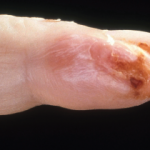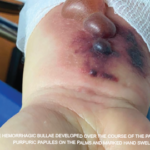Correct!
B) Pigmented purpuric dermatosis (PPD)
PPD is a relatively common dermatologic condition. Distinguishing vasculitis and PPD is most relevant, as the two can be easily clinically confused. Traditionally, there are five subtypes of PPD (See Table 1). Considerable clinical and histopathologic overlap may exist between subtypes. All subtypes of PPD share common features, including:
- They are benign disorders.
- There are no associated systemic symptoms.
- The characteristic appearance includes petechiae and/or violaceous or copper-brown macules and papules.
- Lesions tend to occur in dependent areas, such as the lower extremities and buttocks, but can be seen anywhere on the skin surface.
- Though the etiology is not well understood, the skin changes are thought to represent perivascular inflammation and deposition of hemosiderin.1 Vasculitis, with vessel wall damage and fibrin deposition, is not a feature.
The most common subtype of PPD is Schamberg’s purpura. This eruption is characterized by copper-brown macules covered with pinpoint-sized petechiae, often described as resembling cayenne pepper. This subtype is most commonly seen on the lower legs of older men, although cases in children have been reported.2 Pigmented purpuric lichenoid dermatitis (Gougerot-Blum syndrome) is a variant that clinically resembles Schamberg’s purpura, but lesions tend to be raised and more deeply violaceous, which is likely due to the presence of a lichenoid band seen histologically. Lichen aureus is another subtype of PPD that demonstrates a lichenoid band histologically. This variant manifests with the sudden onset of golden-brown macules and papules that do not blanch with pressure. Segmental subtypes of this variant have been described.3 A variant known as Ducas and Kapetanakis pigmented purpura is characterized by eczematous scaly patches with petechiae, and is the most likely subtype to be associated with pruritus. Purpura annularis telangiectodes (Majocchi’s disease) is perhaps the most clinically distinctive of the five subtypes, and presents with annular blue–red scaly patches with petechiae. These patches can extend peripherally and become atrophic at the center. This is the only subtype that is thought to occur more frequently in adolescent females.4 Several other rare types of PPD have been described, including granulomatous, linear, familial, and transitory, though these types are rare.5
The precise pathogenesis of PPD is unknown. It has been speculated that cell-mediated immunity and Langerhan cells play an important role in inciting inflammation.5,6 Histologically, there is a lymphocytic infiltrate surrounding superficial vessels, along with hemosiderin deposition within macrophages and endothelial swelling with erythrocyte extravasation. There is no vessel wall destruction or fibrin deposition.5,7 Tissue specimens can demonstrate a variable amount of spongiosis or a lichenoid infiltrate depending on the subtype.
The clinical picture is usually sufficient to make the diagnosis of PPD, and most cases do not require laboratory investigations. In select cases, a biopsy may be warranted to rule out vasculitis or other clinical mimickers, such as in rare cases, cutaneous T-cell lymphoma. There is some controversy as to whether there is an association between PPD and cutaneous T-cell lymphoma (CTCL); however, common belief is that CTCL and PPD are distinct entities that can, in rare cases, bear clinical resemblance.7
Though benign, PPD can be pruritic and distressing, and adequate treatment can be difficult. Medium to high potency topical corticosteroids are generally attempted as first-line therapies when treatment is warranted. Occasionally, oral antihistamines may help relieve pruritus. If lesions on the lower extremity are associated with venous stasis, compression stockings may be of benefit. Additional off-label therapies include phototherapy, pentoxyphylline, griseofulvin, and cyclosporine, which may be helpful in select cases. No single treatment is uniformly effective and recurrences often occur. Spontaneous remission over months to years is not uncommon.
Table 1
Clinical and histologic features of PPD
| Clinical features | Unique histologic features | |
| Schamberg’s purpura |
Copper-brown macules with “cayenne pepper” petechiae | |
| Gougerot-Blum syndrome | Small coalescing violaceous papules | Lichenoid band (dense band-like lymphocytic infiltrate in the superficial dermis) |
| Lichen aureus | Sudden onset of golden-brown macules and papules | Lichenoid band (dense band-like lymphocytic infiltrate in the superficial dermis) |
| Ducas and Kapetanakis pigmented purpura | Eczematous scaly patches with petechiae | Spongiosis (edema of epidermis) |
| Purpura annularis telangiectodes | Annular blue–red scaly patches with petechiae |
Dr. Femia completed a fellowship in dermatology–rheumatology at Brigham and Women’s Hospital in Boston, MA, and is now an assistant professor in the department of dermatology at New York University. She is a diplomat of the American Board of Dermatology.
Dr. Merola is an instructor in the department of dermatology at Harvard Medical School and an instructor in the department of medicine, division of rheumatology at Brigham and Women’s Hospital, both in Boston. He is the assistant program director for the combined medicine–dermatology training program and a diplomat of the American Board of Dermatology and the American Board of Internal Medicine.
References
- Zaballos P, Puig S, Malvehy J. Dermoscopy of pigmented purpuric dermatoses (Lichen Aureus): A useful tool for clinical diagnosis. Arch Derm. 2004;140:1290-1291.
- Torrelo A, Requena C, Mediero IG, Zambrano A. Schamberg’s purpura in children: A review of 13 cases. JAAD. 2003;48:31-33.
- Lee HW, Lee DK, Chang SE, et al. Segmental lichen aureus: Combination therapy with pentoxifylline and prostacycline. J Eur Acad Dermatol Venereol. 2006;20:1378-1380.
- Tristani-Firouzi P, Meadows KP, Vanderhooft S. Pigmented purpuric eruptions of childhood: A series of cases and review of literature. Pediatr Dermatol. 2001;18:299-304.
- Sardana K, Sarkar R, Sehgal VN. Pigmented purpuric dermatoses: An overview. Int J Dermatol. 2004;43:482-488.
- Aiba S, Tagami H. Immuno-histologic studies in Schambergs’ disease: Evidence for cellular immune reaction in lesional skin. Arch Dermatol. 1988;124:1058-1062.
- Magro CM, Schaefer JT, Crowson AN, Jingwei L, Morrison C. Pigmented purpuric dermatosis: Classification by phenotypic and molecular profiles. Am J Clin Pathol. 2007;128:218-229.
- Kavala M, Zindanci I, Sudogan S, et al. Mycosis fungoides presenting as hypopigmented and pigmented purpura-like lesions: Coexistence of two clinical variants. Eur J Dermatol. 2011;21:272-273.


